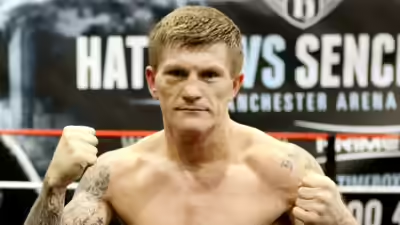Why Ricky Hatton was called ‘The Hitman’ — The shocking truth behind his brutal boxing style

What killed Ricky Hatton? What to kno as ex-boxing world champion dies at 46
There are nicknames that are flattering, nicknames that are funny, and then there are nicknames that tell you everything you need to know before the bell rings. For Ricky Hatton — “The Hitman” — the sobriquet was less a marketing slogan and more a compact biography: a promise of relentless pressure, sudden finishing power and nights when the crowd went home believing they had witnessed something visceral and undeniable.
A name born from style, not spin
Hatton’s moniker never arrived as accidental popculture trivia. It stuck because his boxing did exactly what a “hitman” in fiction does: find the target, close the distance, and finish the job. Hatton was not a stylized counter-puncher or a slick technicalist who dazzled with footwork; he was an up-front, body-first aggressor who bullied opponents onto the ropes, poured in flurries and pursued stoppages with dogged intent. That style translated into real results — 32 knockouts in 45 wins — figures that explain why so many fans and peers attached the “Hitman” tag.
READ ALSO
What killed Ricky Hatton? What to know as ex-world boxing champion dies at 46
Power inside pressure: how Hatton made hitting look inevitable
What set Hatton apart was the way he combined compact, thudding punches with square-on pressure. Rather than relying on one single “big” shot, he built hurt cumulatively: short hooks to the body, snapping uppercuts, and looping shots to the head that landed as punishment over rounds. Opponents who tried to move were sucked back in by Hatton’s footwork and timing; those who stood still were slowly dismantled. The result was a record full of late stoppages and corner retirements that suited the Hitman label — he didn’t always drop you in the opening minute, but he made you pay and then finished what he started.
The Tszyu night: a nickname’s greatest proof
Nicknames become gospel when the fight tape backs them up. On 4 June 2005, Hatton’s demolition of Kostya Tszyu in Manchester — forcing the defending champion’s corner to stop the fight after 11 rounds — did more than win a world title; it vindicated Hatton’s whole method. Against a peer widely regarded as one of the division’s most complete fighters, Hatton’s volume, heart and ability to land telling blows late in the contest made the “Hitman” label feel earned rather than affixed. For many fans it was the moment Hatton stopped being merely a local hero and became the living embodiment of his nickname.
Persona and presentation: Manchester’s hitman, loved by fans
A nickname lives beyond ring mechanics — it survives on image. Hatton cultivated a persona that fit the tag: brash, accessible, and utterly at ease with being Manchester’s son in the global spotlight. His walkouts, his relationship with the crowd at the MEN Arena, the roars that followed his forward-thundering approach — all of that amplified the “Hitman” mythology. Fans didn’t just come to see punches; they came to watch a man who would chase moments of impact, knowing he’d either land them or die trying. That blend of personal brand and ring identity turned a nickname into a cultural shorthand for a certain kind of fight night.
Technique beneath the aggression
There’s a lazy reading of Hatton that reduces him to “just an angry banger.” A closer look shows layers: excellent positional punching (especially to the body), an iron chin, a deceptively simple defensive awareness when he needed it, and a pace-setting engine that broke opponents’ rhythm. Coaches and analysts often pointed to his timing — the split-second adjustments that turned a string of punches into a telling sequence. In other words, the “hit” in Hitman was not just brute force: it was placement, persistence and a capacity to make hits accumulate into decisive damage.
The fights that confirmed the tag — and those that complicated it
Hatton’s resume reads like a list of hit-or-miss showdowns that proved his label. The rises over Jose Luis Castillo and Juan Urango showcased his finishing instincts; the high-profile losses to Floyd Mayweather Jr. and Manny Pacquiao exposed limits when matched with elite defensive virtuosity or explosive power beyond his weight class. Still, even in defeat Hatton’s identity as “The Hitman” remained intact because he never abandoned the approach that earned it: he took the action to the opponent. Those losses complicated the myth but never erased the core truth — Hatton’s fights felt like missions, and he usually carried out the brief.
Today we lost not only one of Britain’s greatest boxers, but a friend, a mentor, a warrior, Ricky Hatton.
As fighters, we tell ourselves we’re strong — we train, we sweat, we take hits, we get up. But sometimes the hardest fight happens in silence, in the mind. Mental health… pic.twitter.com/JwSaYJe6XE
— Amir Khan (@amirkingkhan) September 14, 2025
Breakdown: How “The Hitman” Did His Work
1. Hatton vs. Kostya Tszyu (June 4, 2005 – Manchester)
Round 7, 1:45 mark
Hatton slips inside Tszyu’s jab, digs a left hook to the body, then immediately whips a short right upstairs. The double-level attack forces Tszyu to cover low, leaving him open to further punishment. This body-head rhythm became the defining motif of the fight.
Round 11, final minute
A sustained barrage of body shots pins Tszyu against the ropes. Hatton rips four consecutive left hooks to the ribs, each thudding louder than the last, before finishing with a straight right to the chin. Exhausted, Tszyu doesn’t answer the bell for Round 12 — a textbook “Hitman” finish.
2. Hatton vs. José Luis Castillo (June 23, 2007 – Las Vegas)
Round 3, 0:50 mark
Hatton closes distance with a quick jab, then shifts his weight to drive a left hook into Castillo’s liver. Castillo visibly winces, confirming Hatton’s ability to hurt even granite-chinned opponents with body work.
Round 4, 2:05 mark
The fight’s decisive sequence: Hatton feints high, dips, and buries a perfectly-timed left hook under Castillo’s right elbow. The delayed reaction — Castillo grimacing, taking two steps back, then dropping to one knee — cements this as one of the most famous body-shot knockouts of the 2000s.
3. Hatton vs. Floyd Mayweather Jr. (Dec 8, 2007 – Las Vegas)
Round 1, opening minute
Hatton charges in, smothering Mayweather on the ropes with rapid-fire combinations to the head and body. Though few land cleanly, the pressure sets the tone and demonstrates Hatton’s “Hitman” mentality: attack first, ask questions later.
Round 6, 1:10 mark
A rare success — Hatton lands a stiff left hook to the jaw after pinning Mayweather against the corner post. For a moment, the crowd roars as Mayweather absorbs the shot. It’s one of the clearest examples of Hatton breaking through elite defense with persistence.
Round 10, 1:05 mark (the finish)
Mayweather counters with a short left hook as Hatton charges forward, sending him into the turnbuckle and down. Although Hatton is stopped, the sequence underscores the double-edged nature of “The Hitman” style — the same aggression that made him beloved also left him vulnerable against the best.
Legacy: more than a nickname
Nicknames fade; legacies endure. Hatton’s “Hitman” era is part of a broader arc — a boy from Stockport who became a two-division world champion and then, later, a coach and public figure who spoke about personal struggles as candidly as he fought in the ring. The title “Hitman” will live in highlight reels and in the shorthand of boxing conversation, but it’s the full story — the craft, the crowd, the career highs and the human lows — that secures his place in the sport’s memory. Even as debates will continue over where he ranks among the greats, anyone looking for a quick explanation of why fans used the name need only watch the old tapes: Hatton didn’t just punch; he pursued, connected and finished. That relentless clarity is why “The Hitman” fits so cleanly


